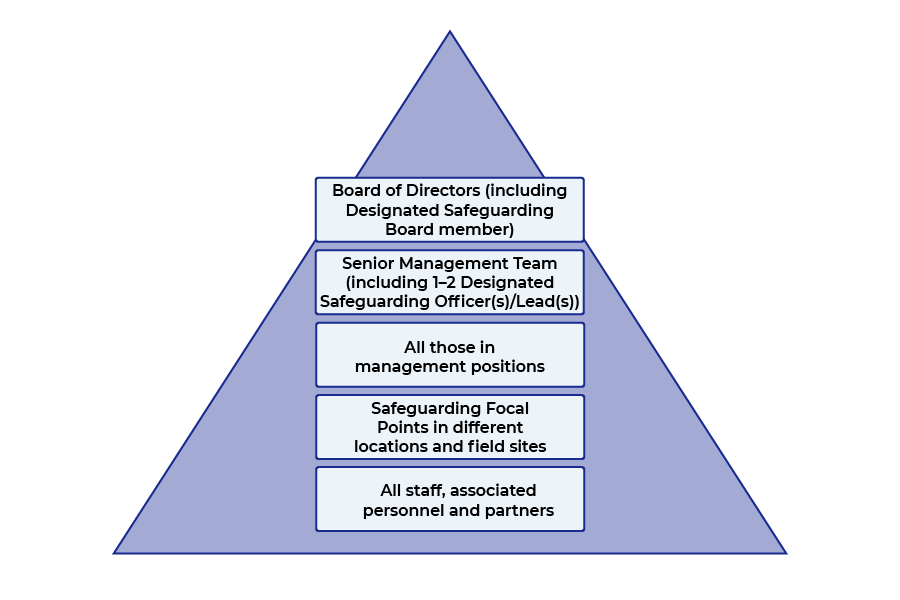6.3 The role of Safeguarding Focal Points
Once everyone has had their induction training into safeguarding, you will need to think about how this training can be replicated at the project level – particularly if your organisation is working in different locations in one country or in different
countries. Also, who will be in a position to ensure safeguarding is kept on the agenda?
It’s good practice to identify persons at different offices, locations and field sites to undertake the role of Safeguarding Focal Points (SFP) or sometimes known as “Safeguarding Champions”. Safeguarding may be added on top of their usual work.
SFPs would be required to support staff and associated personnel to understand safeguarding responsibilities under the policy and be the ‘go to’ person for reports at the field level.
SFPs will require support, training and mentoring to carry out their tasks, which Designated Safeguarding Officers/Leads (who are usually at head offices, although not always) must consider in their plan. DSOs are those in senior positions who have the
authority to make decisions.
The diagram below illustrates the responsibility for safeguarding in aid agencies.


View transcript
0:29
ANEETA: Great question, Shereen. As you have a full-time role as a monitoring and evaluation advisor for your organisation, the role of safeguarding focal point is an additional role which can take up time. That’s why it’s important that short job
descriptions are written up and agreed. Focal point should be both men and women, and they should be provided training and support to do this additional role. When you’re having to deal with a safeguarding concern, things can get a bit hectic,
so inform your line manager confidentially, and they should redistribute your work to free up your time to focus on the concern, if this is what the organisation’s safeguarding league has suggested.
Watch this video about Sherine, who loves being a Safeguarding Focal Point but finds it sometimes takes up a lot of her time.
For more detail on defining this role follow the link to:
Safeguarding
Leads & Focal Points: Defining Your Role Worksheet
Develop a job description for a Safeguarding Focal Point

© D.Georgiev / Shutterstock
|

Activity 6.2 Developing a job description
Use the list of questions below to start developing a job description for a Safeguarding Focal Point at field or project locations:
- What knowledge, experience and skills should a Safeguarding Focal Point have?
- What would be some of the key responsibilities they would have to undertake?
- How much time from their regular work would this include? (e.g., 10–15% of their time? Note this may increase if they also undertake training or investigations.)
- Are there country or regional level PSEA networks which SFPs can be part of that will support the mapping of available services?
|

Want to find out more?
After compiling your ideas for a job description go to Plan
International’s Guidance for Safeguarding Focal Points to see what other points you might have included.
What advice do you have for a new Safeguarding Lead or Focal Point?

View transcript
0:08
KAYLA BRITTAN: So, if I had to give any advice to a new safeguarding lead, I’d say first and foremost, be proactive. Identify any possible risks that you may see within the context that you’re working in and set procedures and structures in place
to make sure that you can ensure the safety of children and vulnerable adults in your projects or in your organisation. Also, remember that you’re not there to do it alone. Prep your team, prepare your team, make sure that everyone is aware of
the structures that need to be put in place and ensure that there’s a culture of awareness consistently.
0:42
ANGELINE FADZAI MANYONGA: I would say that a new safeguarding lead has to be a very open-minded person, a very friendly person, easily approachable as well, and they have to also be firm at the same time, because you need to take all allegations seriously.
You need to be approachable in the sense that people are free and can trust you. You need to be a person who does not say things out, just disclosing people’s information. We have to be someone who knows the ethical side of working with people.
1:18
NOAH SSEMPIJJA: You should keep your ears on the ground. You should give or provide enough information to your staff about safeguarding, offer safeguarding training. They should understand the safeguarding policy.
1:34
PAULAMI DE SARKAR: So, safeguarding is not just a big box exercise. It is about embedding safeguarding in the culture of the organisation. And it is important to familiarise with each procedure of your organisation. It is important for the persons
have enough knowledge and understanding [INAUDIBLE] framework. As a safeguarding lead, it is important to make yourself available to other staff and safeguarding focal points in different pockets. Now, it is important to follow a non-judgmental
behaviour and follow the best interest of children. Principle in each cases of decision making, take the help of senior management, who makes safeguarding a priority issue [INAUDIBLE] making and management documents.
2:22
As a safeguarding lead, it is important to advocate for prioritisation of safeguarding in the organisation.
2:28
ANANDA KING: I would say that it’s very important to be open-minded and to constantly be able to work in one’s own assumptions and biases. We don’t necessarily think about our biases on the daily basis. But we do have a lot. Each one of us have a
lot of biases, right? So, avoiding them to take place and to overshadow a fair capacity of judgement is very important in this work. And to have a real willingness to learn and grow. So, if you have the opportunity to work in humanitarian projects,
for example, the richness of different views and opinions is so great that you can lose a great opportunity to evolve as a human being.
3:15
So, other points of view and learnings are out there, waiting to be absorbed.
Watch the video above, in which several people working in international organisations share some top tips about being a Safeguarding Lead or Focal Point.

![]()

![]()
![]()